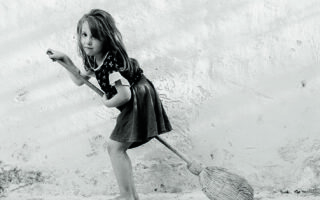Cindy Sherman at the Cycladic
Works of the 70-year-old photographer with ‘a thousand faces’ on display in Greece for the first time

She evokes a sense of deja vu, as if I’ve encountered her somewhere before, familiar yet elusive. She embodies the essence of a woman of “indeterminate age,” elegantly dressed while pedaling a distinctive bicycle through the streets of New York. Emerging from a vintage clothing store laden with bags, her slender silhouette catches the eye. Her once-blonde hair has gracefully transitioned to a soft gray, her features remain gentle, her eyes are blue. If pressed to speculate on her profession, I might suggest actress, gymnast or university professor. Pausing the YouTube video featuring her, I switch to another, slightly older one. “I am an artist who happens to use the camera as my tool so some people would call me a photographer,” she introduces herself.

It is 2020 and she has just been awarded the Wolf Prize in Arts. She is wearing an oversized short-sleeved hoodie. The hoodie is wrinkled, perhaps unironed, and on top of it, the award hangs like a medal. Her comfortable, airy bob must have been blow-dried. Its waves seem to be set with strong hairspray. Not a single strand flies out of place as she moves her head. It’s as if she wants to present herself as relaxed while, in reality, she has complete control over every single hair. In a video from the same day, with the same haircut, I notice that her hair is unkempt and tangled at the back. Ultimately, her hairstyle cannot reveal much about her. Regardless, she has done her makeup to look as though she is not wearing any, leading me to the arbitrary conclusion that she wants to appear “naturally beautiful.” This is Cindy Sherman, the most famous visual artist of the Pictures Generation, renowned for her series of works – each untitled, sequentially numbered by her gallerists, and classified into thematic narratives – wherein she takes pictures of herself while obscuring her identity. After all, these are not self-portraits or mere selfies; they are metamorphoses.
Her cinematic universe
I stumbled upon Sherman’s work roughly 20 years ago. A mix of fear and, mostly, curiosity were the sentiments I recognized on her overexposed (with the help of a spotlight) face and her piercing blue gaze locked onto mine through her untitled photograph Number 92 from the 1981 series “Centerfolds.” These “Centerfolds” were reminiscent of the two-page spreads in popular erotic magazines at the time, showcasing women in suggestive poses. This specific piece, along with others from the same series, as well as selections from “Untitled Film Stills” (1977-1980), “Rear Screen Projections” (1980), and “Color Studies” (1982), will be featured in the upcoming exhibition “Cindy Sherman at the Cycladic: Early Works,” organized by the Museum of Cycladic Art.

Blurring the lines between photography and performance art, Sherman’s works serve as a poignant critique of societal stereotypes surrounding women, as perpetuated in cinema, television and magazines. Notably, her untitled photograph Number 96 fetched a staggering $3.89 million at a Christie’s auction in 2011, setting a record at the time for the most expensive photograph ever sold. Currently, Man Ray’s “Le Violon d’Ingres,” auctioned by the same house in May 2022 for $12.4 million, holds the top spot on the list of the 30 most expensive photographs worldwide. However, Sherman claims six positions on this list, ranking fifth, sixth, 18th, 21st, 23rd and 30th.
While Sherman, dubbed as “the woman of a thousand faces,” occasionally explores outdoor settings and enlists other photographers, including her father in the past, to capture her image, she primarily works solo in her studio. Here, she crafts the “scenario” for each piece, directing, designing and lighting it herself. She transforms into the protagonist-model, executing her own makeup, hair and wardrobe until she achieves the desired effect, often using a mirror placed behind her camera to gauge the composition. Since the early 2000s, she has also delved into digital photography and editing, posing against green screens and digitally manipulating backgrounds. This approach is evident in series like “Clowns” (2003-2005), where she explores kitsch aesthetics, and “Society Portraits” (2008), characterized by elegant and compassionate yet ironic compositions, often punctuated with deliberate “errors,” such as hastily positioned wigs, underscoring the constructed nature of her imagery.
In her grandmother’s clothes
To trace the genealogy of her technique, we must delve into Sherman’s childhood, where she often found herself seated in front of the television, completing homework while indulging in movies, or playing dress-up in her grandmother’s attire. Born in January 1954 in Glen Ridge, a township in New Jersey with now approximately 7,000 residents, young Cindy relocated with her family – comprising four older siblings, with a 19-year gap between her and the eldest – to Huntington, a small town nestled within the New York metropolitan area. At the age of 18, she took up her fine arts studies at the State University of New York (SUNY) in Buffalo. It was during this time that she realized the limitations of expressing herself through painting, feeling devoid of originality. And so, she contemplated using a camera to express her ideas, allocating the time saved from the meticulous brushwork to the development of the concept.

Shortly after graduating, and with the encouragement of her then-partner and fellow artist Robert Longo (known for his artworks featured in the apartment of Patrick Bateman in the 2000 film “American Psycho”), who watched her transform with the clothes she purchased from thrift stores every time they went to a party, the four years from 1977 to 1980 resulted in the photographs that thrust her into the public eye: the “Untitled Film Stills,” comprising 69 black-and-white photographs. In 1995, the collection was acquired by MoMA for an estimated 1 million dollars. Depicting Sherman herself in various roles set against diverse backdrops, these images capture archetypal female characters – the ingenue actress, the suburban housewife, the career girl – reminiscent of frames from American film noir, Italian neorealism, and 1940s-1960s B-movie horror flicks.
Sherman’s works serve as a poignant critique of societal stereotypes surrounding women, as perpetuated in cinema, television and magazines
Initially showcased at Artists Space in New York, where Sherman worked as a receptionist, these frames left an indelible mark on the art world. In 2014, James Franco recreated 29 of them, titled the series “New Film Stills,” and exhibited them at the Pace Gallery, receiving predominantly negative reviews. More recently, the somewhat affected YouTuber Rachel Oates posted a video analyzing whether Sherman’s work has a feminist dimension or not (and whether this is of any significance), all the while casually promoting the wine she was enjoying during the recording. However, Sherman’s inaugural solo exhibition didn’t take place at the space where she worked but rather at The Kitchen, a venue still active in Chelsea, renowned for championing avant-garde performances and experimental art. This establishment has been associated with the showcasing of works by luminaries such as Laurie Anderson, Meredith Monk, Philip Glass, Michael Nyman, Brian Eno, and David Byrne (Byrne was Sherman’s partner from 2007 to 2011) – alongside his band, Talking Heads.
Is she really a feminist?
In the ensuing decades, Sherman’s photographic series evolved, embracing color and expanding in scale. She drew inspiration from the “great masters” of painting, the flappers of the 1920s, horror movie heroines, affluent art aficionados, and fashion influencers. In 2017, she unlocked her previously private Instagram account, unveiling a trove of grotesque, digitally distorted selfies, a motif echoed in her most recent works, which debuted this year at the Hauser & Wirth gallery in New York.
While none of her later series, barring the 2008 “Society Portraits,” achieved the iconic status of her early works, and though she is predominantly recognized for her character portraits featuring herself as the model, significant chapters in her career saw her delve into “still lifes.” In series such as “Disasters and Fairy Tales Images” (1986-1989), “Close Ups” (1996), and the “Black and White Series” (1999), Sherman either eschewed self-portraiture entirely or employed it selectively, often integrating store mannequins and objets trouves to create imagery that was kitschy, visually violent, conceptually macabre, and sexually deviant. Among these, the most controversial remain the “Sex Pictures,” crafted in 1992, coinciding with the release of Madonna’s “Erotica” album and “Sex” book. In this series, Sherman utilized parts from dolls sourced from medical equipment catalogues to compose pseudo-pornographic scenes, including sausages protruding from (or entering) the hairy crotch of a legless doll with an aged visage. Notably, five years later, Madonna funded the retrospective “Cindy Sherman: The Complete Untitled Film Stills,” showcased at MoMA.

Reflecting on her oeuvre, Sherman has asserted that “the work is what it is,” suggesting that it can be viewed through a feminist lens. While film theorist Laura Mulvey has dissected the relationship between Sherman’s imagery and the “male gaze,” the artist herself acknowledges that she hasn’t delved into all the theoretical analyses of her work, and some remain elusive to her comprehension. Fashion is another field that has long intrigued and inspired her, as evidenced by her subversive portrayal, devoid of conventional glamour, in a 1983 campaign for New York boutique Diane B., clad in designs by Jean Paul Gaultier, Issey Miyake, Comme des Garcons, and others. The campaign featured in Interview magazine. Her most lengthy collaboration with Marc Jacobs further attests to her fascination with the sartorial realm. While her forays into cinema have been met with mixed success, she has made cameo appearances as herself in films by John Waters (“Pecker”) and her former husband, Michel Auder (whom she married in 1984 and divorced in 1999).
The key to success
In today’s age, many of us engage in the act of self-photography, or more accurately, capturing our various personas (as we can embody different identities, such as our professional self versus our social self) through self-staging. This process varies in attention to detail, level of skill, and use of filters and digital enhancements. On social media platforms like Instagram, we may adopt roles ranging from sexy and available to distant, culinary expert, athletic, or humorous.

However, when Sherman began her artistic exploration, such self-portraiture was relatively uncommon, and the motivations behind it differed from those of her contemporaries. In a way, she seemed to have “seen the future.” On her own Instagram, Sherman interestingly employs popular image editing apps in a subversive manner, to make herself look aged, unattractive, or peculiar, almost alien-like. Her works, of course, are not selfies but rather portray roles; they do not capture real-life situations but instead resemble made-up compositions. As such, they serve as a reminder that the identities we project in our daily lives are also constructed. They act as mirrors that confront us with a revealing truth. And this is, certainly, a success.
The exhibition “Cindy Sherman at the Cycladic: Early Works” will be showcased at the Stathatos Mansion neoclassical wing from May 30 to November 4.
The original version of this article appeared in K, Kathimerini’s Sunday supplement.





